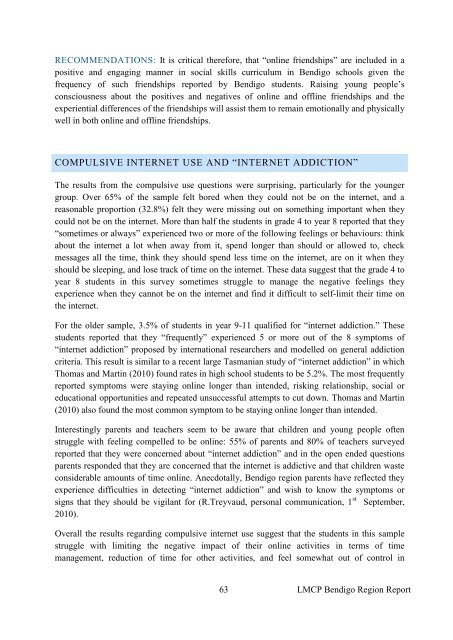LODDON MALLEE - Cyber Safe Kids
LODDON MALLEE - Cyber Safe Kids
LODDON MALLEE - Cyber Safe Kids
You also want an ePaper? Increase the reach of your titles
YUMPU automatically turns print PDFs into web optimized ePapers that Google loves.
RECOMMENDATIONS: It is critical therefore, that “online friendships” are included in a<br />
positive and engaging manner in social skills curriculum in Bendigo schools given the<br />
frequency of such friendships reported by Bendigo students. Raising young people‟s<br />
consciousness about the positives and negatives of online and offline friendships and the<br />
experiential differences of the friendships will assist them to remain emotionally and physically<br />
well in both online and offline friendships.<br />
COMPULSIVE INTERNET USE AND “INTERNET ADDICTION”<br />
The results from the compulsive use questions were surprising, particularly for the younger<br />
group. Over 65% of the sample felt bored when they could not be on the internet, and a<br />
reasonable proportion (32.8%) felt they were missing out on something important when they<br />
could not be on the internet. More than half the students in grade 4 to year 8 reported that they<br />
“sometimes or always” experienced two or more of the following feelings or behaviours: think<br />
about the internet a lot when away from it, spend longer than should or allowed to, check<br />
messages all the time, think they should spend less time on the internet, are on it when they<br />
should be sleeping, and lose track of time on the internet. These data suggest that the grade 4 to<br />
year 8 students in this survey sometimes struggle to manage the negative feelings they<br />
experience when they cannot be on the internet and find it difficult to self-limit their time on<br />
the internet.<br />
For the older sample, 3.5% of students in year 9-11 qualified for “internet addiction.” These<br />
students reported that they “frequently” experienced 5 or more out of the 8 symptoms of<br />
“internet addiction” proposed by international researchers and modelled on general addiction<br />
criteria. This result is similar to a recent large Tasmanian study of “internet addiction” in which<br />
Thomas and Martin (2010) found rates in high school students to be 5.2%. The most frequently<br />
reported symptoms were staying online longer than intended, risking relationship, social or<br />
educational opportunities and repeated unsuccessful attempts to cut down. Thomas and Martin<br />
(2010) also found the most common symptom to be staying online longer than intended.<br />
Interestingly parents and teachers seem to be aware that children and young people often<br />
struggle with feeling compelled to be online: 55% of parents and 80% of teachers surveyed<br />
reported that they were concerned about “internet addiction” and in the open ended questions<br />
parents responded that they are concerned that the internet is addictive and that children waste<br />
considerable amounts of time online. Anecdotally, Bendigo region parents have reflected they<br />
experience difficulties in detecting “internet addiction” and wish to know the symptoms or<br />
signs that they should be vigilant for (R.Treyvaud, personal communication, 1 st September,<br />
2010).<br />
Overall the results regarding compulsive internet use suggest that the students in this sample<br />
struggle with limiting the negative impact of their online activities in terms of time<br />
management, reduction of time for other activities, and feel somewhat out of control in<br />
63 LMCP Bendigo Region Report


